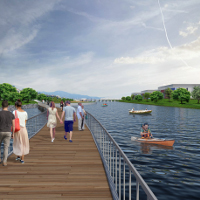Waterfront and urban regeneration
DOI:
https://doi.org/10.6092/1970-9870/3990Keywords:
waterfront, regeneration, Genoa port-cityAbstract
The purpose of this paper is to understand if the strength of water is so important like in the past and to see like this element can be the driving force for redevelopment and urban regeneration of a city- port.
The waterfront represents those parts of a city develop from the contact with the water until to involve the inner parts, it is a sort of permeable urban surface where the link with water is able to conjugate the different ways to live this special bond. This view permits to look at the waterfront, not only as a simple urban area well defined, but it is a new method to watch the city that draws the inspiration from the water for its future assets, without to forget its identity.
Genoa represents an example of Mediterranean city (such as Marseille, Valencia and Barcelona).
Our research brings from a debate among the different actors (University, Planning Section of the Municipality, Port Authority) to an elaboration of some future proposals which underline the different meanings of the relationship with water in the west of Genoa, Prà-Voltri’s area: from walking on different levels, above and below the channel specially designed, the opportunity to live (as in previous years) the beach for swimming, recreational and sporting appearance in a new Channel, in the continuation of activities in the existing Prà Channel. These elaborations are designed to determine the functions that the new Channel could take becoming in turn an urban redevelopment tool: the influence of the Channel, in fact, it should reach the city center reconnecting to historical paths and the promenade to become an integral part of the everyday life.
Downloads
References
Alemany, J. & Bruttomesso, R. (eds) (2011). The Port City of the XXI century. New challenges in the relantionship between Port and City. Venice: Rete.
Alvarez, F., Casanovas, R., Montaner, J.M. & Muxi, Z. (eds.) (2014). Reader. Modelo Barcelona 1973-2013. Barcelona: Comanegra.
Bamani, A., & Ronsivalle, D. (2008). Città d’acqua. Risorse culturali e sviluppo urbano nei waterfront. Roma: Aracne Editrice.
Bauman., Z. (2000). Liquid Modernity. Cambridge: Cambridge University Press.
Batisse, M. & Grenon, M. (eds) (1989). Futures for the Mediterranean basin: The Blue Plan. Oxford: Oxford UniversityPress.
Bertoncello, B. & Dubois, J. (2010). Marseillee Euroméditerranée, accélérateur de métropole. Marseille: Parenthéses.
Breen, A. & Rigby, D. (eds.) (1994). Waterfronts. New York, McGraw Hill.
Bruttomesso, R. (eds.) (1993). Waterfronts: A new frontier for cities on water. Venice: International Centre Cities on Water.
Calvino, I. (1979). Invisible Cities, London: Picador.
Campisano, G. & Muratore, G. (1983). El Jardì del Turìa. Metamorfosi della città tra natura e cultura: un esempio spagnolo. Roma: Clear.
Carta, M. (2012). Palermo Waterfront, the fluid city planning, Portus, 24, 88-95.
Carta, M. & Ronsivalle, D. (eds.) (2016). The Fluid City Paradigm. Regeneration as an Urban Renewal Strategy. Switzerland: Springer International Publishing.
Carta, M. (2010). Dal waterfront alla città liquida. In M. Savino (ed.), Waterfront d’Italia. Piani, politiche, progetti. Milano: FrancoAngeli.
Castells, M. (1997). The Power of Identity. Oxford: Blackwell.
Dovey, K. (2005). Fluid City: Transforming Melbourne’s Urban Waterfront. Sydney, University of New South Wales Press Ltd, Routledge.
Ferrari, F. (2007). Genova, città di camerieri. In G. Borelli. (ed.), Capitali del nord-ovest. La politica economica delle città italiane. Milano: Franco Angeli.
Fisher B. et al. (2004). Remaking the urban waterfront. Washington: Urban Land Institute.
Gabrielli, B. (2005). Politiche per la città di Genova. Urbanistica Informazioni, 202.
Gaja Díaz, F. (1993). Grandi progetti urbanistici nella città di Valencia: il giardino del fiume Turia. Territorio, 16.
Gastaldi, F. (2012). Grandi eventi e rigenerazione urbana negli anni della grande trasformazione di Genova: 1992- 2004. Rivista internazionale di cultura urbanistica, 5(9).
Giovinazzi, O. & Moretti, M. (2009), Città portuali e waterfront urbani: trasformazioni e opportunità. Porto, mare e città. Tema. Journal Of Land Use, Mobility And Environment, 2(3). 7-16. doi:10.6092/1970-9870/83.
Greco, N. (1989). La città e i suoi mari. Il waterfront tra sostenibilità e governance. Milano: FrancoAngeli.
Grenon, M. & Batisse, M. (eds) (1989). Futures for the Mediterranean basin: the Blue Plan. Oxford: Oxford University Press.
Guala, C. (2015). Mega eventi. Immagini e legacy dalle Olimpiadi alle Expo. Roma: Carocci.
Hoyle, B. (1988). Development Dynamics at the Port-City Interface. In B. Hoyle, D. Pinder, M Husain (eds), Revitalising the Waterfront. Londra, Belhaven. 3-19.
Lynch, K. (2013). L’immagine della città. Vicenza: Marsilio.
Moretti, M. (2008). Città d’acqua e waterfront. Una sfida strategica per il futuro. Argomenti di Architettura, Architettura e Città. 3.
Rajchman, J. (1999). Effetto Bilbao/The Bilbao Effect. Casabella. 673-674.
Ridolfi, E. & Valdelvira, M. (2011). Evoluzione e Prospettive per il Waterfront di Barcellona. Portus Plus. 1.
Terrin, J. (ed) (2014). Villes inondables. Cities and flooding: prevention, adaptation, resilience. Marsiglia: Parenthèses.

Downloads
Published
How to Cite
Issue
Section
License


